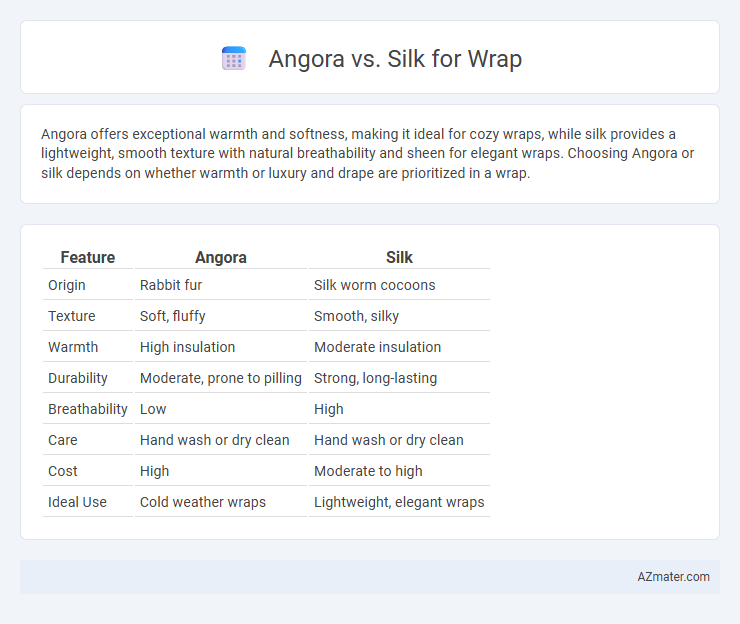Angora offers exceptional warmth and softness, making it ideal for cozy wraps, while silk provides a lightweight, smooth texture with natural breathability and sheen for elegant wraps. Choosing Angora or silk depends on whether warmth or luxury and drape are prioritized in a wrap.
Table of Comparison
| Feature | Angora | Silk |
|---|---|---|
| Origin | Rabbit fur | Silk worm cocoons |
| Texture | Soft, fluffy | Smooth, silky |
| Warmth | High insulation | Moderate insulation |
| Durability | Moderate, prone to pilling | Strong, long-lasting |
| Breathability | Low | High |
| Care | Hand wash or dry clean | Hand wash or dry clean |
| Cost | High | Moderate to high |
| Ideal Use | Cold weather wraps | Lightweight, elegant wraps |
Introduction to Angora and Silk Wraps
Angora wraps, crafted from the soft undercoat of Angora rabbits, offer exceptional warmth and a luxurious texture ideal for cold weather accessories. Silk wraps, made from fine natural fibers spun by silkworms, provide a lightweight, breathable, and smooth alternative, perfect for delicate and elegant styles. Both materials excel in softness and comfort, with Angora known for insulation and Silk prized for its sheen and drape.
Origin and Production of Angora and Silk
Angora wool originates from the Angora rabbit, primarily bred in Turkey and China, known for its fine, soft fibers harvested by gentle combing or shearing to avoid animal harm. Silk is produced from the cocoons of the Bombyx mori silkworm, predominantly cultivated in China and India, where the larvae spin continuous silk threads during metamorphosis. Both materials require labor-intensive processes, with Angora focusing on animal welfare during fiber collection and silk involving careful extraction and reeling of delicate silk filaments.
Texture and Softness Comparison
Angora fibers are known for their exceptional softness and fluffy texture, providing a luxurious, warm wrap that feels gentle against the skin. Silk offers a smooth, sleek texture with a natural sheen, delivering lightweight softness and a cool, breathable feel. While Angora excels in warmth and plushness, Silk stands out for its silky smooth touch and elegant drape.
Warmth and Insulation Properties
Angora fibers provide exceptional warmth and insulation due to their hollow core that traps heat efficiently, making angora wraps ideal for cold climates. Silk, while lightweight and smooth, offers moderate thermal regulation but excels in moisture-wicking and breathability, which makes silk wraps suitable for milder conditions. The insulating power of angora outperforms silk, making it a superior choice when maximal warmth and heat retention are priorities in wrap materials.
Breathability and Comfort Levels
Angora fibers offer exceptional warmth and softness but are less breathable than silk, making them better suited for cooler climates in wrap usage. Silk wraps excel in breathability and moisture-wicking properties, providing lightweight comfort ideal for warmer weather or long wear. Choosing between Angora and silk for wraps depends on desired temperature regulation and comfort, with silk delivering superior airflow and Angora offering cozy insulation.
Durability and Longevity
Angora fiber boasts remarkable durability due to its fine, resilient structure, making it highly resistant to wear and tear in wrap use. Silk, known for its natural tensile strength, offers exceptional longevity while maintaining a smooth, lustrous texture that resists pilling and fraying. Both materials provide lasting wrap options, but Angora excels in warmth retention alongside durability, whereas Silk balances elegance and endurance.
Care and Maintenance Requirements
Angora wraps require gentle hand washing with cold water and mild detergent to prevent fiber damage and maintain softness, as agitation can cause felting or shedding. Silk wraps demand careful cleaning with delicate or dry cleaning methods, preserving the fabric's smooth texture and preventing shrinkage or color fading. Both materials benefit from air drying flat away from direct sunlight to maintain shape and longevity.
Price Difference: Angora vs Silk
Angora wrap prices typically range from $80 to $200 depending on quality and brand, while silk wraps generally cost between $100 and $250, reflecting the luxury status of silk fibers. The higher price of silk is due to its labor-intensive production process and smooth texture, whereas angora prices vary based on the source of hares and yarn purity. Consumers seeking budget-friendly options often prefer angora wraps, appreciating the warmth and softness at a lower cost compared to premium silk wraps.
Eco-Friendliness and Ethical Considerations
Angora fiber is often criticized for ethical concerns due to animal cruelty issues in its production, whereas silk production involves the boiling of silkworms, raising questions about insect welfare. In terms of eco-friendliness, Angora has a lower environmental footprint when sourced from ethical farms practicing humane harvesting, while silk requires intensive water and energy use in sericulture. Choosing sustainably certified Angora or peace silk, which allows silkworms to emerge naturally, offers more ethical options for eco-conscious consumers seeking wraps.
Which Material Suits Your Needs?
Angora offers exceptional softness and warmth, making it ideal for cozy wraps in cold weather, while silk provides a lightweight, breathable option suited for elegant, year-round wear. Consider angora if you prioritize insulation and a luxurious feel, especially in winter, whereas silk excels in moisture-wicking properties and a smooth, lustrous finish perfect for sensitive skin. Your choice depends on whether warmth or breathability aligns better with your wrap's intended use and comfort preferences.

Infographic: Angora vs Silk for Wrap
 azmater.com
azmater.com